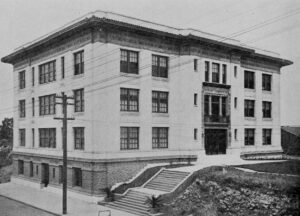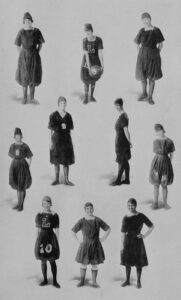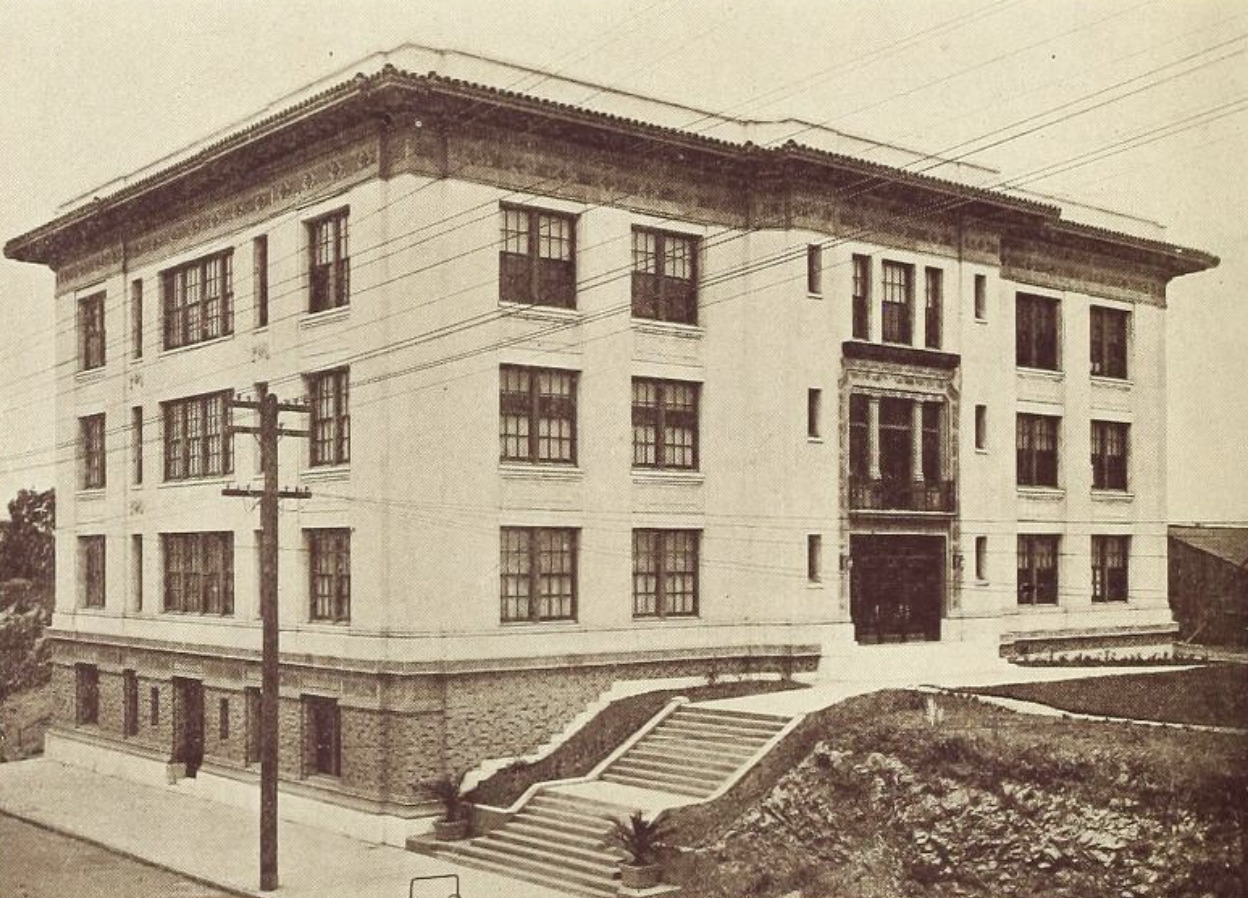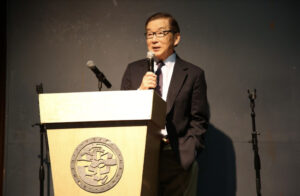In the days of the original Potrero Street campus — when the California School of Mechanical Arts (Lick) and the Wilmerding School of Industrial Arts were not yet hyphenated as one — there was a third school in the association. “The Lux School for Industrial Training for Girls” taught the women of Lick-Wilmerding-Lux, a trio of independent schools under the same administration.
Along with sharing a campus, Lux shared a common culture with Lick and Wilmerding. “To do common things uncommonly well,” was the Lux motto, wholly agreeing with the values of the other two schools.
The school’s history begins in the mid-19th century, with Charles and Miranda Lux.
Mr. Lux was a butcher who joined Henry Miller in 1858 to start a cattle-dealing business in California. Miller & Lux, as it was called, became the largest cattle producer in the state and one of the largest landowners in the country. “It used to be said that Miller & Lux cattle could be driven from one end of California to the other and rest each night on land owned by that firm,” wrote Lick-Wilmerding-Lux director George Merrill in the December 1928 edition of L.W.L. Life, the schools’ student publication.
As Miller & Lux grew rapidly, Mrs. Lux worked with Sarah B. Cooper, the mother of the kindergarten movement in California. While Cooper advocated for children and women in San Francisco, Mrs. Lux supported her financially. Cooper argued in favor of a new “manual training” movement, also known as industrial education.
Merrill described the practice as “education through the correlated activity of the mind and hand — or, better, the mind and any or all of the five senses, rather than from the printed page alone.”
Mrs. Lux supported industrial education for women. In 1894, she endowed a school with the purpose to teach girls five subjects: sewing and textiles, cooking, health, art and retailing and merchandising. Mrs. Lux passed away before it was founded, but her vision of creating an industrial arts school for women was born.
The Lux School for Girls was opened in August 1912. Although the Lick and Wilmerding schools had previously been co-ed, their women were reorganized into Lux’s first class of 120 students. This separation grouped the students by gender rather than by programs, because the girls and boys engaged in a different curriculum, which led the Lick and Wilmerding schools to be commonly referred to together as Lick-Wilmerding (LW).
LW held one set of classes, teachers and student officers, while Lux had its own. Provisions could be made for Lux students to attend LW classes they were interested in that Lux didn’t offer.
Lux didn’t have its own campus when the school first opened, so it held its classes within the buildings of LW. However, Lux immediately began construction on land purchased from LW at 2450 17th Street at Potrero, adjacent to LW’s Potrero Street buildings.

Courtesy of the LWHS Archives
Many of the boys worked in their classes on projects to construct furniture, design a stage and even plan a tennis court for Lux’s new building. Lux finished construction in 1913 and the girls began classes in the new building in the middle of the school year.
In addition to ordinary classrooms, the building featured a laundry, living room and bedroom, all of which held classes. The structure of the building mirrored the culture of the school — “When one speaks of Lux, the word school is hardly ever added, because everyone thinks of it as a home, not a school,” a student wrote in the 1917 edition of L.W.L. Life.
The Lux students’ regular classes included English, mathematics, science, physical education, dance and botany.

Photo by Gabriel Moulin Studios 1914
These classes highlighted their practical application within the home — rather than learning an entire physics course, they would learn the physics behind electricity and heating.
Lux was known for its industrial training programs. “Industrial training” held different definitions for the boys and the girls. Whereas the LW curriculum featured mechanics, forgery and architectural drawing, the Lux curriculum offered classes such as sewing, cooking and housekeeping.
Students that took Lux’s cooking courses learned to make various dishes in the school’s cooking laboratory. All of the food prepared in Lux’s cooking classes was utilized in the cafeteria and served to both Lux and LW students.
Sewing was a popular course at Lux, evident by a consistent rhythmic hum of electric machines in the sewing room, hard at work on various projects from bags to tailored suits to baby clothes to dresses. These dresses were displayed to the school in a fashion show held yearly. The seniors made their graduation dresses from scratch, the entire cost under five dollars.
Students used the interdisciplinary drawing courses to work on designs and small projects, including their dress designs for sewing. They also made batiks, commercial art and designed posters for all sorts of purposes around school.
The Lux girls were always seen wearing unique hats, handmade in the millinery class. They learned stitches, folds and embroidery, adding bows, rosettes, flowers and ornaments to their hats.
The home department provided Lux girls with an opportunity to design their own houses and learn the fundamentals of housekeeping. Students worked on blueprints for rooms and created entire house plans including estimates for furnishings.
According to the 1914 edition of The Tiger, the home classes included lectures ranging from things like furnishing and arrangement of draperies to art history, architecture and pottery.

Courtesy of the California Historical Society
Aside from the physical house courses, the girls were taught to take care of the home. They learned to do laundry and had training in first aid, taking frequent trips to hospitals to care for the sick. They also learned hygiene, including “the correct walking, standing and sitting postures.” They practiced their skills in the Ginn Home across the street, where boarders and orphaned boys attending LW lived.
Another part of the industrial training curriculum included field trips to industrial plants in San Francisco and the Bay Area. Students watched and learned the manufacture of all sorts of products, ranging from mayonnaise to mattresses.
Lux wasn’t only a high school — the institution also offered Junior College (J.C.) and a Normal Course at various points across the school’s history. The J.C. at Lux began in 1930, providing students with vocational education to become experts in specific areas, like becoming a nurse or a dental assistant. The J.C. students engaged in all of the same activities ordinary students did, participating in sports and clubs.
The “Normals” of Lux were female high schoolers and high school graduates learning to become teachers. They trained and practiced teaching in public schools and at Lux. When they graduated from the Normal Course, they received a certificate from the state, entitling them to teach the subject they focused on in California. The subjects ranged from domestic science to home economics.
The Normals, around 50 students per year, were also responsible for much of the behind-the-scenes work at the school. They were in charge of the cafeteria, including planning, buying and serving meals. They also gave lectures to the other students in the Lux seminar class.
The seminar class offered at Lux took place every three weeks. Accompanied by slide images produced by a stereopticon, guest speakers would come to Lux and teach the students short, deep-dive lessons on random topics. One day the students would learn about library work, and the next, they would try their hand at pantomiming.
The girls loved the seminars, and many stepped up to teach them. Juniors and seniors gave talks based on personal experiences, historical events or something interesting they researched. Faculty would come during their off time to watch and learn something new from their students.
Lux was immediately embraced by its student body, which was proud to be a part of such a unique school. They started new clubs, sports teams and traditions almost immediately. One tradition was the “Lux Girl’s Afternoon Tea,” where all the girls were invited to socialize every Thursday after school. One student from each grade was appointed to host each week’s tea, which was originally held in LW’s “bungalow,” but after the building’s completion, was moved to Lux’s living room.

Courtesy of the LWHS Archives
The girls worked hard to maintain a strong bond between the underclassmen and upperclassmen. They did so through social events like dances, dinner parties and hikes.
The Lux girls also held receptions to initiate newcomers. In this service, new students would dress in “long Grecian robes and hold lighted candles signifying the spirit of Lux. Various symbols of vocations toward which one may work at Lux, such as a sheaf of wheat for culinary arts, a palette for the fine arts and books for the literary professions were presented to the newcomers,” according to the 1935 L.W.L. Life. The service would close with the new students giving the Lux pledge. Each new class would also plant a tree in the school’s garden to serve as permanent reminders of the class’ spirit and loyalty to Lux.
Within the first few years of the school, the administration attempted to merge the social interests of Lick-Wilmerding-Lux. The schools were far from separate, and much of their activities were done together. Rallies swept through the halls of each building. Dances and events for the schools were often held on Lux’s rooftop garden, dubbed “The Roof.”

Courtesy of the California Historical Society
Many clubs were doubled between the schools but remained actively interconnected. For example, an all boys Glee Club was popular at LW while the all girls version was at Lux. However, the two chapters joined once or twice a week to sing together. They also held performances both individually and in conjunction.
The “pioneer in the movement for co-operation” — creating interconnected clubs within the three schools — was the Lick-Wilmerding-Lux Debating Society. While the Society joined together for organization, planning and social events, they did most of the actual debating separately.
Having these distinct clubs within the schools gave the women more opportunities to be involved in activities. A student wrote in the 1914 edition of The Tiger that after Lux was established, the number of girls involved in Debate grew considerably. This might have been because the women were encouraged to engage in their interests without feeling like they were competing against their male counterparts.
Lux also had unique clubs, such as the HiCaBo Club created in 1926. The girls combined the Hiking Club, Camera Club and Botany Club, taking walks together while stopping for pictures and learning about flowers.
Beginning in 1928, the Lux women were expected to participate in at least one activity year-round. Some joined clubs or theater productions and others played sports.
The Lux athletes proudly wore the school’s colors, white and gold, as they competed in baseball, swimming, tennis, volleyball, kickball, German bat ball (schlagball) and basketball.

Courtesy of the LWHS Archives
Basketball was the largest sport at Lux, beginning with one team in 1912. In later years, every section of gym class would have a team, which would play after school against other sections in interclass games on the roof. From that, an all-star team would be made to compete against other schools.
After every home game, Lux athletes would invite the visiting team to join them for light refreshments in the Lux living room.
Around 20 years after Lux’s establishment, San Francisco began to change its views on women’s education. The Lux School noted the importance of women’s education in fields other than the home and began discontinuing high school classes in 1930. In 1942, the school only offered J.C. courses and was renamed the “Lux College.”
The Lux College was a “Technical, Semiprofessional College for Girls,” and it was tuition-free thanks to the endowment of Miranda Lux. Upon graduating from the two-year college, students would receive an Associate of the Arts degree, options for majors being dental assisting, medical assisting, pre-nursing, retailing and distributive education, apparel designing and production and decorative arts. The school was known as a place where women could gain economic independence and gave women opportunities they couldn’t find anywhere else.
88-year-old Marjorie Albarran graduated from Lowell High School and enrolled in Lux College in 1952. When Albarran attended Lux, LW was building a new campus and moved to a transitional location before going to Ocean Avenue. Albarran said, “Some of the Lick boys came over because they were the janitors in our building. It’s funny that I remember that. We didn’t have any exchanges, no dances with them or anything.”
Albarran trained to become a medical assistant because she wanted to be in the medical field, but she didn’t want to be a nurse. She loved learning about medicine, especially through the lab work Lux provided. Lux taught her skills to work in multiple medical careers throughout her life, leading her to eventually work at the UC Medical Center, as a medical secretary and a dermatologist assistant.
In 1953, one and a half years through Albarran’s two-year course, Lux shut down with no warning. “We had six months more to go and they said we had to close the school down. They told us at that time it was embezzlement of funds.” This was the end of Lux for good.
A report from May 4, 1953, said that the school’s purpose was to offer courses of instruction that weren’t available in other educational institutions. At the time Lux was created, it was ahead of its time. But by the middle of the century, there were many other public programs, colleges and junior colleges that made “Lux College unnecessary from an educational (and financial) standpoint.”

Courtesy of LWHS Archives
All the students attending Lux at the time, including Albarran, were transferred to San Mateo’s Junior College. Albarran was extremely unhappy about this transition. She believed Lux gave her a much better education and she disliked the new school and commute. Many of the girls couldn’t get down to San Mateo from San Francisco, so they had to drop out.
In 1955, the trust became the Miranda Lux Foundation. Still in operation today, the foundation “awards grants to organizations and programs in the San Francisco Bay Area that serve young people under the age of 18,” their website explains.







